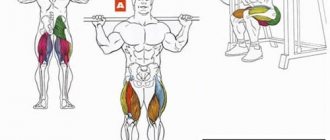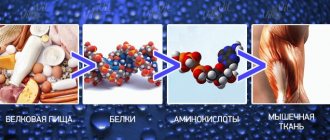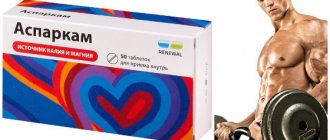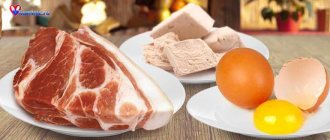This article is devoted to the biography of a bodybuilding titan from the 90s. – Greg Kovacs. In it you will learn his story, unusual facts from his life, as well as the cause of death. Why did this bodybuilder, although he had excellent data, only win once? How did Greg Kovacs' weight and strength reach such incredible levels? You will find answers to these and many other questions in our article.
Let's rewind time...
Greg Kovacs was born into a farming family in Canada. Already as a child he was a fairly large child.
Greg's first hobby was football. Then he became interested in hockey and began playing for the Canadian junior national team. We can say that this period in the boy’s life was a turning point: thanks to playing hockey, he first found himself among training equipment and fell madly in love with them. Having discovered a craving for sports equipment, the young man immediately switched to bodybuilding. This was expected, because with a height of 180 centimeters, he weighed about 105 kilograms.
His debut in the professional field of bodybuilding was rather unsuccessful: at the age of 20, his body was not suitable for professional performances, as it did not correspond to bodybuilding aesthetics - the judges did not find the necessary relief in him, and the poses that he demonstrated were too far from professional.
However, the purposeful, strong man decided not to give up and continued to intensively engage in strength training. Only eight years later, in 1996, Greg Kovacs took first place in the Canadian National Championship.
Cause of death of Greg Kovacs
One of the most famous bodybuilders of our time, Canadian athlete Greg Kovacs gained body weight of 182.5 kg in the off-season and 136-150 kg during competitions, with a height of 193 cm. It is impossible to imagine his gigantic strength! He did not participate in championships in his sport very often and trained mainly for his own pleasure, practicing a new type of training - strength training. The main area of application of his talents was advertising. In the mid-90s, he was the guest of honor at all exhibitions and sales of fitness products. Greg Kovacs' cause of death was a heart attack.
He was born in Canada in 1968 and was a large, massive child from childhood. Greg was always interested in sports and began to play football intensively. Young Kovacs was a promising player and made significant progress on the field. Then, as is customary in Canada, he paid tribute to the most popular “national” sport and was enrolled in the country’s youth hockey team. However, here a decisive event occurred for him, which determined his future fate.
It is customary for hockey players all over the world to regularly visit the gym to stay in shape. Finding himself among the training equipment, Kovacs realized that the barbell was better for him than running on the ice and became interested in bobbodybuilding. The coaches' promises of a brilliant hockey career did not affect him: the choice was made once and for all. Greg liked the dynamics of bodybuilding and the need to constantly fight with himself to achieve the desired result.
His first professional performance took place at the age of 20, and Kovacs lost it: the judges were not satisfied with the “relief” of the young athlete, his inability to pose, taking the most spectacular poses to demonstrate his muscles. It took Greg another 8 years to master all the tricks of competitive bodybuilding. While participating in competitions, he only saw his finest hour in 1996, winning the Canadian National Bodybuilding Championship.
Having excellent, from the point of view of professionals, data, he amazed everyone in the competition hall with his enormous weight. Greg no longer had such significant victories, although, it should be noted, this did not upset him to despair: this athlete trained for himself. According to the testimony of those around him, he was by nature a very friendly and affable person. His charm and complacency as a “mountain man” always impressed the audience, and Kovacs had many fans.
Greg devoted himself selflessly to strength training and, while gaining weight, ate a lot, of course, taking steroids and other drugs that kept the body in the right condition. This often ends badly in bodybuilding practice and there are many examples of this. Experts warn bodybuilders that most often their sport affects the heart, which, along with the increase in mass, acquires alarming proportions. A conscious choice to go extreme, despite the danger, is why Greg Kovacs died at the age of 44. He died of cardiac arrest in 2013.
A huge success that never happened again
At the time of receiving his award, he, according to professionals, had excellent credentials. The audience was amazed by the magnificent height and weight of Greg Kovacs - 182 kg with a height of 191 cm. However, from that moment on, he never distinguished himself in performances. Nevertheless, failures only spurred the bodybuilder to take care of himself: he was constantly in non-stop mode, adhering to the developed diet and training regimen.
As those around him said, Greg Kovacs was a very friendly and friendly person. The audience was always impressed by his complacency and charm as a mountain man, so he had quite a lot of fans and followers. However, not everyone liked him; some of his colleagues spoke rather unflatteringly about him.
Greg Kovacs performance history
He first competed in a bodybuilding tournament in 1996 at the Canadian National Championships, where he confidently took first place. After this show, Greg received a professional card and already in 1997 he tried his hand at the “Night of Champions”, where he finished 16th.
The career of a bodybuilder did not work out as expected. Greg competed until 2005 and his best achievement was 13th place at the Arnold Classic in 2004.
In 2005, he retired from competitive bodybuilding and started his own business. Greg also regularly trains competitive athletes. On November 29, 2010, Kovacs was accused of extortion. Allegedly, Greg was part of a group of offenders who forced the owner of a sports nutrition store, Eriny Mills, to go to the bank and withdraw a large amount of money.
During the course of maintaining the site, the author many times came across information about various outstanding personalities. So I decided to make a small rating of athletes who are outstanding for their size and muscle mass. Rating of mass giants and the largest bodybuilders in the world.
VICTOR RICHARDS
1. And so I decided to give first place to one little-known black bodybuilder. If the information contained on the Internet about him is at least partially true, Victor Richards will take first place. And so, here he is, the biggest bodybuilder! Look at photos of the athlete as a teenager.
Ronnie Coleman vs Victor Richards
At the age of 16, he already looks like a pro. At 18 years old, 107 kg is enough lean muscle mass. While our Russian guys are not accepted into the army due to lack of weight, this boar, with a height of 170 cm, already weighs 107 kg and has arms as thick as the thigh of an average man. For some obscure reason, this bodybuilder competed very little. Perhaps he has a fear of large crowds and stage fear, maybe he really is not prominent and proportional enough, but he is really huge.
At 18 years old, he already looks no worse than any pro.
At 19, he naturally gets even bigger.
Victor Richards, 19 years old, double biceps in front,
In photographs he is often in shape, quite sculpted, but far from competitive, but still huge.
It's a shame he didn't compete much.
According to our veteran bodybuilder N. Yasinovsky, who knew him, Victor Richards’ hip circumference reached 102 cm, and he consumed at least 12,000 kcal per day.
There is no reason not to trust Yasinovsky; he is unlikely to have any reason to promote a little-known niger in Russia. There are several videos on YouTube featuring Victor Richards. It seems that he does not at all look like someone who is afraid to pose on stage. In general, why he did not perform regularly remains a mystery to me. Bodybuilder Victor Richards weighed 164 kg in the off-season, this may not be true, but he really is a monster. Here are his anthropometric data:
Height: 176 cm Weight in the off-season: 164 kg Weight on uniform: 150 kg Biceps: 66 cm Waist: 90 cm Thigh: 93 cm Lower leg: 60 cm Neck: 57 cm Shoulder width: 120 cm Chest circumference: 170 cm
Perhaps Ronnie Coleman was keeping up with Richards in the offseason and if not for his remarkable relief, he would have been noticeably larger.
GREG KOVACH
2. Second place will be given to the huge Canadian bodybuilder Greg Kovacs. Not only is he very heavy, but he is also very tall and strong. According to information from various sources, he used chemicals in horse doses. He hasn't performed for quite some time. He didn’t take many prizes at major bodybuilding competitions due to his specific proportions and muscle definition; he actually looks a little clumsy. He presses some absolutely monstrous weights with his legs and arms. One could give him first place, but in terms of height/weight ratio, Victor Richards will surpass him. It is known that in his teens he already dabbled with 90 kilogram dumbbells. In general, only the devil knows what an athlete with 160 kg of lean muscle mass is capable of. Kovacs is just a monster. Now among competing athletes there is practically no one to compare him with.
It seems that they even made a special leg press machine for Kovacs, so that he could put as much as 900 kg on it. But in this photo he presses these same 900 kg with his legs. Well, YouTube is full of videos of Ronnie Colema leg-pressing 1050 kg for 8 reps. In general, 900kg x 20 and 1050 x 8 are approximately similar results, although 900x20 is probably a little more difficult to squeeze out.
Greg Kovacs' measurements: Height 191 cm Competition weight 153 kg Off-season weight 182 kg Biceps 67 cm Chest 178 cm Thigh 89 cm
The data is quite impressive. Even if they are slightly overpriced, Kovacs is still simply huge. In 1996 he took first place in bodybuilding in Canada. He never achieved such heights anywhere else. In general, he is loved most of all in his homeland.
It's a pity that there are no more such monsters among competing athletes. The Olympia is won by bodybuilders weighing 115 kg. Apparently, this is such a unprofitable sport. Building mass is expensive and doesn't pay off unless you win a major tournament. And winning it is not very easy. The risk is not only money, but also health.
Greg Kovacs Strength Measurements: 725 lbs = 329 kg bench press for several reps 495 lbs x 5 = 224.5 kg overhead press for 5 reps 675 lbs x 6 = 306 kg incline press 6 reps 495 lbs x 6 = 224.5 kg bent over rows 6 times 120 lb x 10 = 54.5 kg dumbbell curls 10 times 200 lb x 12 = 90.7 kg dumbbell press 12 reps
The strength data is simply fantastic and unrealistic. Naturally, all this may not be true. To believe it, you either need to see it yourself, or repeat all these records. Both are beyond reality.
BOB SAPP
3. Unfortunately, this is not a bodybuilder, although it is very similar. This athlete starred in several films. Including “Big Stan” in a place with the famous Randy Couture. He is very popular in Japan, due to the fact that the public there is very fond of all sorts of fights without rules, mixfight, as well as wrestling. I don’t know what to call such fights when clumsy fighters of enormous size participate in them. Freak fights.
In general, something like this. However, this same freak once broke Ernesto Hoost himself. At press conferences he can widen his eyes, make a scary face, and threaten a future enemy. A real clown. In general, he is clumsy and slow, but incredibly massive. Recently, as a fighter, he has been traveling around the world and improving the ratings of fighters around the world, losing one after another. Surely such a guy would hit him like a sledgehammer to the head, but unfortunately, his aim has been off lately and they constantly miss the target.
His data: Height 194 cm Weight 170-180 kg 585 lbs = 265 kg bench press 420 lbs = 190 kg clean and jerk 800 lbs = 363 kg squats
NOAH STEER
4. The largest bodybuilder in height. The tallest, therefore the most massive of the relatively recently competing bodybuilders in the world. His weight reaches 159 with a height of almost 2 meters in the off-season. Indeed, a big guy with 66 cm biceps. His head is even smaller in circumference.
The width of the latissimus dorsi muscles is impressive!
Greetings friends!
Today we’ll talk about the biggest titan of the 90s in bodybuilding, and this is Greg Kovacs. Why did a bodybuilder, possessing such colossal data, get only 1 victory? What principles helped him achieve such strength indicators?
Learn about his training and nutrition.
And here are more articles about bodybuilding monsters:
What was Kovacs hiding?
Intense training and unconventional nutrition, as bodybuilders say, led his body to a non-functional state. You don't often see information about Greg Kovacs' wife, but she was the one who helped him cope with routine matters. He couldn't even travel without her. His wife, Kim, was a real stone wall for this large man. Often she could conduct seminars in his place, since Greg got tired easily, could not stand the heat and was constantly sweating profusely.
Envious colleagues were amazed at how Kim courted Greg: she cut his steak into small pieces and fed him from a fork during amateur competitions. In addition, she had to almost follow him on his heels with a fan, because sweat was simply pouring down from the mountain man.
As it turned out, other bodybuilders also witnessed the fact that he literally could not go to the toilet on his own - his wife followed him everywhere...
Food [edit | edit code ]
Greg Kovacs has 700 grams of protein and exactly 1 kilogram of carbohydrates on his menu every day.
“I believe,” he explained, “that the fundamental factor in a bodybuilder’s nutrition is protein. Every day I have about 2 kg of meat and 12 eggs on my table. To this I add 3 more servings of protein drink. In the off-season, I take 700 g of protein and exactly 1 kilogram of carbohydrates daily. A total of 7 meals. I try to vary natural proteins: for example, half a kilo of beef at one time, then chicken plus 4-6 eggs, then fish. Carbohydrates are the classics: potatoes, rice, oatmeal. My favorite meal is a big steak with potatoes or rice, a big plate of vegetable salad and yogurt for dessert. When I have to deviate from my diet, for example, during the holidays, I immediately feel a loss of energy. Nutrition for us bodybuilders is the most important thing!”
| Greg Kovacs | |
| Body-builder | |
| personal information | |
| Born | Born December 16, 1968 Niagara Falls, Ontario (1968-12-16) |
| died | November 22, 2013 (2013-11-22) (age 44) Mississauga, Ontario |
Grigory Mark Kovach
(December 16, 1968 – November 22, 2013) was a Canadian IFBB professional bodybuilder.
According to Canadian bodybuilding publication, Muscle Insider
, Kovacs retired from competitive bodybuilding in 2005 to start his own business and coach competitive athletes.
Where did fate take the giant next?
The power style turned Kovacs into a real giant. However, he turned out to be absolutely uncompetitive from an aesthetic standpoint; sometimes he was called a bear.
When Greg realized that his genetics, which favored size and power rather than aesthetics and symmetry, were failing him, he left competitive bodybuilding in 2005. After leaving the stage, he completely immersed himself in business and coaching. Now his activity consisted of traveling around the world promoting MuscleTech sports nutrition. He managed to visit many countries of the world, including Russia.
Dallas McCarvel
This American guy went down in history as the youngest IFBB PRO card holder. Received professional status at the age of 21. He made a career in the advertising business. He had one of the most prestigious sponsors - the sports nutrition company BSN. Dallas died at the age of 26 from a heart attack.
What is the cause of death of Greg Kovacs?
After his career ended, the athlete faced many trials. The divorce from his beloved wife was a great shock for him. This psychological shock unsettled Greg. Then in November 2010, the bodybuilder was accused of extortion: the owner of a sports nutrition store reported that Kovacs demanded a large sum of money from him. This prank led to Greg spending several months behind bars. After his release, the former bodybuilder decided to return to the field of bodybuilding, but as a journalist. In April 2011, he began writing articles for the website rxmuscle.com. Greg turned out to be a talented writer: he has written numerous articles about bodybuilders and bodybuilding in general.
Greg's first health problems began back in 2008: he was doing a standing press with a weight of 200 kg in a fitness center in Toronto and suddenly collapsed unconscious on the floor. After this incident, he was taken to the hospital, where he was on life support for some time.
Greg Kovacs died at 9:50 a.m. on November 22, 2013, due to a heart attack. This happened in Ontario, at his home in Mississauga. Greg has no children.
Although he wasn't exactly lucky in terms of size, people say he was a friendly man with a great sense of humor.
Greg Kovacs Program
“Only strength training gives you mass,” said the bodybuilder, and he was absolutely right.
To train his chest, he performed up to 4 warm-up sets of 20 reps, 3 work sessions of 8–10 takes. In split:
- Smith presses, lying on a straight bench, sitting in a machine;
- spreading shells on a bench at an angle;
- working with the upper block in a crossover.
“Maximum isolation is important for the biceps.”
The athlete believed that free weights and peak muscle contractions when working in machines allowed him to increase his volume. Typical hand program:
- alternating dumbbell lifts;
- EZ-bar lift;
- bending the limbs on a cable block.
I pumped my back, hips, and legs with deadlifts, bent-over rows, leg curls in the machine, and calf raises.
Anthropometric data of a bodybuilder
Greg Kovacs height is 191 centimeters.
The bodybuilder's competitive weight is 153 kilograms.
Weight between seasons reached 182 kilograms.
Volumes:
- biceps – 67 cm;
- hip – 89 cm;
- chest – 187 cm.
Of course, such data could not go unnoticed; many were jealous of his build - not all bodybuilders lift super-heavy dumbbells. Greg's workout videos show that he easily handled a 305kg dumbbell incline press!
Sometimes he worked with more powerful implements during training.
Personal matter[edit | edit code]
Name
: Greg Kovacs.
Date of Birth
: 12/16/1968
Date of Death
: 11/25/2013
Place of Birth
: Niagara Falls, Ontario, Canada.
Location
: Fonthill, Ontario, Canada.
Somatotype (type of build)
: endomesomorph.
Height
: 191 cm.
Weight
: in the off-season - 182.5 kg, competition - 136-150 kg.
Biceps: 65 cm, calves - 60 cm, thigh - 89 cm, waist - 114 cm, chest volume -178 cm (weighing 182.5 kg).
Professional career
: since 1996
Trainer
: Victor Muñoz.
Best Achievements
:
- 1996: Canadian National Championship - 1st place.
- 1997: “Night of Champions” - 16th place.
- 1998: Ironman Pro - 16th place.
- 2003: Arnold Classic - 13th place.
- 2004: Arnold Classic - 13th place.
Some more interesting facts from the life of Kovacs
According to the bodybuilder's biography, he usually ranked 12th or 13th throughout his athletic career. When he realized that he would not see any laurels, he began to study exclusively for himself, and later began to train young guys.
As Kovacs himself believed, he took after his grandfather: there were legends among people about his superhuman strength. Unique genetic baggage required very little to bring to light the biggest and most powerful professional in history. When the inexperienced Greg was still a 17-year-old boy, he, still far from a “kid” of bodybuilding, already weighed 110 kilograms! Moreover, all his weight was pure muscle! His size earned him the nickname "Canadian Godzilla."
When it became clear that the usual assortment of weights no longer satisfied the giant, super-heavy projectiles began to be made especially for him.
His leg press reached 900 kilograms (20 repetitions per set), his bench press reached 306 kilograms - 3 times in a row!
Kovacs could easily juggle 115-kilogram dumbbells (6 repetitions per set).
His face was featured in fitness industry advertising campaigns. He rarely competed, but was not deprived of public and media attention.
His heart attack occurred due to excessive force loads, according to the examination.
Interesting facts from life
From the biography it is known that the bodybuilder took 12th or 13th place in competitions throughout his entire sports career. Greg didn't set such goals for himself, he trained more for himself, and also trained other young guys.
He was often featured in advertising campaigns for the fitness and nutrition industries. Kovac rarely competed, but was always the center of media attention.
In 2013, the athlete’s heart stopped, the cause of death was a heart attack. As the examination showed, the heart could not withstand such force loads.
Greg's Life Principles
He had three main principles:
- Firstly, he believed that it was necessary to avoid a comfortable state during training. If the body gets used to the load, it is urgent to quit or change boring exercises, look for new options that will lead to a state of nausea. The result of severe torture is inevitable muscle growth. Weak muscles are strengthened through uncomfortable exercises.
- Secondly, Greg believed that regular exercise is the key to success. Only sustained and regular training will lead to an increase in muscle mass. Breaks, Greg believes, only disrupt hormonal and physiological processes. Without breaks, the body builds muscle much faster in the required volume.
- Thirdly, self-discipline. Greg said that without it the desired result could not be achieved. You need to constantly work with your head and direct all your thoughts to training in the gym.
How did Kovacs eat?
If you look at the photo of Greg Kovacs, you will notice pronounced muscle mass. He increased it by consuming large amounts of protein. He had 7 meals a day; the giant ate 2 kilograms of meat and a dozen eggs. In addition, protein drinks were always on his menu. Of course, there were also vegetables in his diet - he considered carbohydrates important for obtaining energy in order to fully devote himself to classes in the gym.
As Greg said, his favorite dish is a vegetable salad with potatoes or rice and a large meat steak. His favorite dessert was natural yogurt.
Since Greg devoted himself selflessly to strength training, he intensively gained weight and took steroids. There is information that he took other medications that helped him maintain his body in the right condition. As you know, the use of certain supplements negatively affects the health of bodybuilders, but without them it is impossible to bring the body to ideal.
Experts recommend that bodybuilders avoid this kind of stimulants, as they negatively affect the functioning of the heart and liver - due to the increase in muscle mass, these organs acquire alarming sizes. Greg was an extreme person in everything, from his thoughts to his training in the gym.
Food[edit | edit code]
Greg Kovacs has 700 grams of protein and exactly 1 kilogram of carbohydrates on his menu every day.
“I believe,” he explained, “that the fundamental factor in a bodybuilder’s nutrition is protein. Every day I have about 2 kg of meat and 12 eggs on my table. To this I add 3 more servings of protein drink. In the off-season, I take 700 g of protein and exactly 1 kilogram of carbohydrates daily. A total of 7 meals. I try to vary natural proteins: for example, half a kilo of beef at one time, then chicken plus 4-6 eggs, then fish. Carbohydrates are the classics: potatoes, rice, oatmeal. My favorite meal is a big steak with potatoes or rice, a big plate of vegetable salad and yogurt for dessert. When I have to deviate from my diet, for example, during the holidays, I immediately feel a loss of energy. Nutrition for us bodybuilders is the most important thing!”











